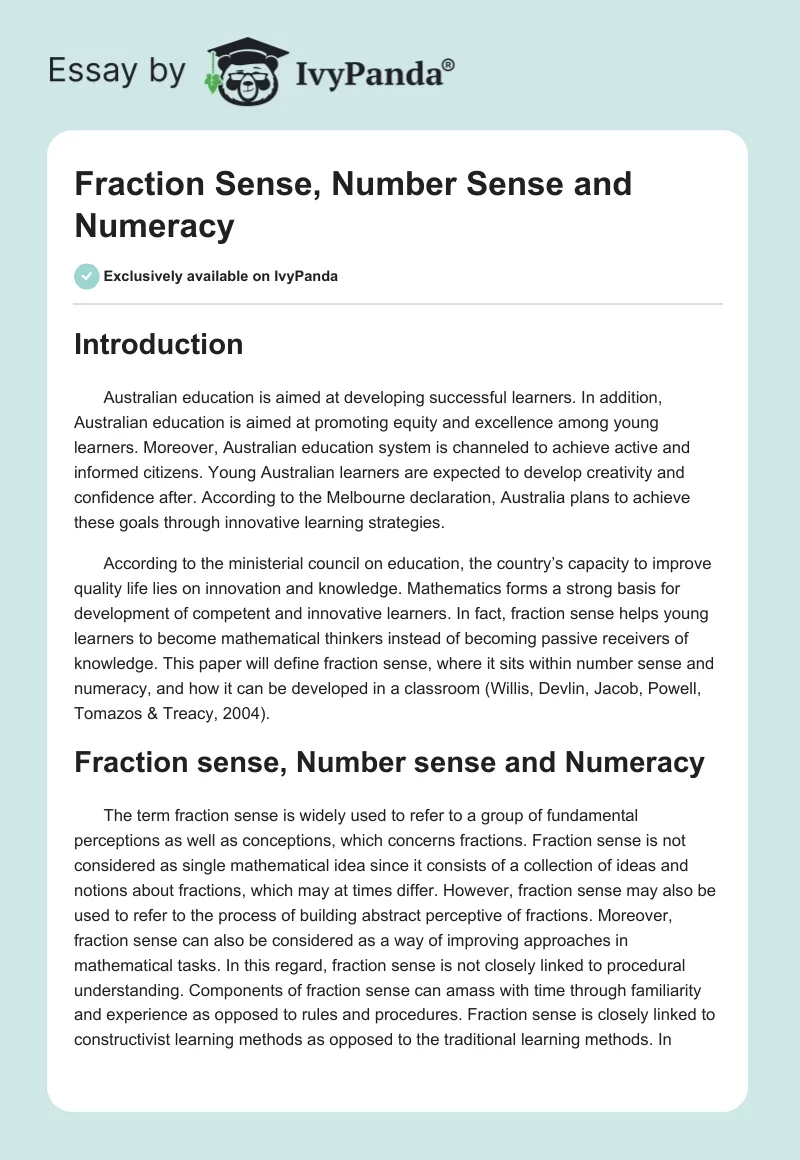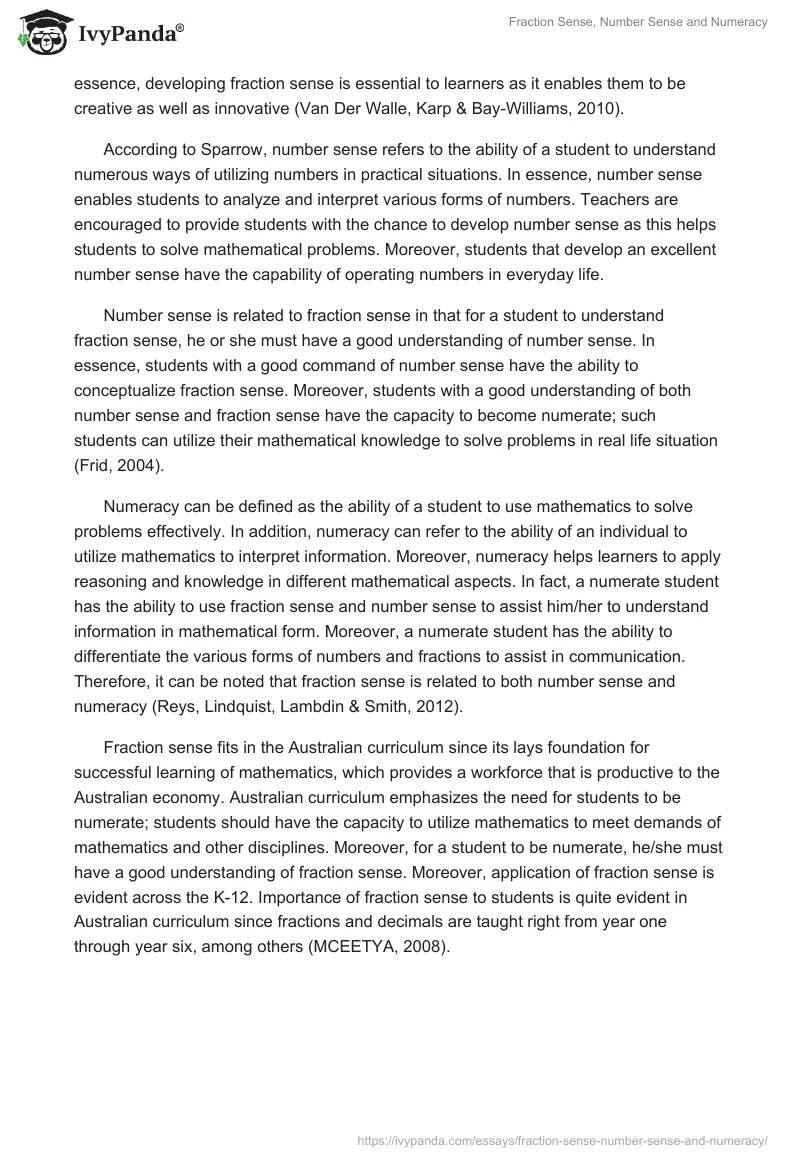Introduction
Australian education is aimed at developing successful learners. In addition, Australian education is aimed at promoting equity and excellence among young learners. Moreover, Australian education system is channeled to achieve active and informed citizens. Young Australian learners are expected to develop creativity and confidence after. According to the Melbourne declaration, Australia plans to achieve these goals through innovative learning strategies.
According to the ministerial council on education, the country’s capacity to improve quality life lies on innovation and knowledge. Mathematics forms a strong basis for development of competent and innovative learners. In fact, fraction sense helps young learners to become mathematical thinkers instead of becoming passive receivers of knowledge. This paper will define fraction sense, where it sits within number sense and numeracy, and how it can be developed in a classroom (Willis, Devlin, Jacob, Powell, Tomazos & Treacy, 2004).
Fraction sense, Number sense and Numeracy
The term fraction sense is widely used to refer to a group of fundamental perceptions as well as conceptions, which concerns fractions. Fraction sense is not considered as single mathematical idea since it consists of a collection of ideas and notions about fractions, which may at times differ. However, fraction sense may also be used to refer to the process of building abstract perceptive of fractions. Moreover, fraction sense can also be considered as a way of improving approaches in mathematical tasks. In this regard, fraction sense is not closely linked to procedural understanding. Components of fraction sense can amass with time through familiarity and experience as opposed to rules and procedures. Fraction sense is closely linked to constructivist learning methods as opposed to the traditional learning methods. In essence, developing fraction sense is essential to learners as it enables them to be creative as well as innovative (Van Der Walle, Karp & Bay-Williams, 2010).
According to Sparrow, number sense refers to the ability of a student to understand numerous ways of utilizing numbers in practical situations. In essence, number sense enables students to analyze and interpret various forms of numbers. Teachers are encouraged to provide students with the chance to develop number sense as this helps students to solve mathematical problems. Moreover, students that develop an excellent number sense have the capability of operating numbers in everyday life.
Number sense is related to fraction sense in that for a student to understand fraction sense, he or she must have a good understanding of number sense. In essence, students with a good command of number sense have the ability to conceptualize fraction sense. Moreover, students with a good understanding of both number sense and fraction sense have the capacity to become numerate; such students can utilize their mathematical knowledge to solve problems in real life situation (Frid, 2004).
Numeracy can be defined as the ability of a student to use mathematics to solve problems effectively. In addition, numeracy can refer to the ability of an individual to utilize mathematics to interpret information. Moreover, numeracy helps learners to apply reasoning and knowledge in different mathematical aspects. In fact, a numerate student has the ability to use fraction sense and number sense to assist him/her to understand information in mathematical form. Moreover, a numerate student has the ability to differentiate the various forms of numbers and fractions to assist in communication. Therefore, it can be noted that fraction sense is related to both number sense and numeracy (Reys, Lindquist, Lambdin & Smith, 2012).
Fraction sense fits in the Australian curriculum since its lays foundation for successful learning of mathematics, which provides a workforce that is productive to the Australian economy. Australian curriculum emphasizes the need for students to be numerate; students should have the capacity to utilize mathematics to meet demands of mathematics and other disciplines. Moreover, for a student to be numerate, he/she must have a good understanding of fraction sense. Moreover, application of fraction sense is evident across the K-12. Importance of fraction sense to students is quite evident in Australian curriculum since fractions and decimals are taught right from year one through year six, among others (MCEETYA, 2008).
Elements of mathematics children should know relating to fraction sense
Research has shown that developing a strong fraction sense is significant in mounting conceptual understanding of rational numbers in schools. Moreover, developing fraction sense improves flexibility with representing fractions. According to the Australian curriculum, essential elements of fraction sense that should be learnt by students include understanding of the part-whole model, which concerns definition of fractions as equal parts of a whole. In addition, students should be able to name fractions both in written form (symbolically) and in verbal form. Students should also learn and conceptualize the relationship between the number parts; this should be distinguished from the relative size of the parts. This would help students to know that, as quantities are divided, they become smaller and smaller. Moreover, students should also know the size of fractions in comparison to whole. This should include knowledge on whether the fractions are more, equal or less than one (Frid, 2004).
According to the Australian curriculum, students are required to be able to recognize as well as name representations of fractions utilized commonly when it is the only part visible. Moreover, students are required to have the capability of visualizing, estimating and creating representations of fractions by partitioning wholes (ACARA, 2014). This should be done to by utilizing different models to avoid stereotyping responses.
The curriculum targets that children with a comprehensive understanding of the basic components of a fraction sense named above would have the capability of utilizing mental descriptions of fractions. In addition, the curriculum targets that students with good understanding of fraction sense would construct complex processes as well as concepts. Complex construction of processes and concepts can help students to comprehend representation of various fractions such as eighths, quarters, halves and thirds and how such representations can be added or subtracted to form one whole (Sparrow, 1994).
Factors that can affect students developing fraction sense
A number of factors may impede of encourage students to conceptualize fraction sense. However, it should be noted that the main factor that affects students’ ability to develop fraction sense is the teaching strategies employed by the teacher. For instance, traditional teaching methods utilized before have been found to limit students’ ability to conceptualize fraction sense. According to Piaget, children learn better by constructing concepts from the inside than by internalizing concepts from the outside. In this regard, children should be considered as active thinkers as opposed to considering them as passive receivers of information.
According to Sparrow, teaching strategies should involve inquiries and problem solving methods that engage students in discussing, justifying as well as explaining their tasks. Moreover, teachers should make mathematics interesting and exciting to improve classroom participation of students. In essence, teachers should implore the use of digital operations as well as mental processes in calculations. Therefore, constructivist teaching and learning should be adopted to achieve innovative learners (Kamii & Lewis, 1990).
Students have stuck to the misconception that fractions can be applied in specific ways only. Teachers tend to put limits on the learning of fractions; these limits have arisen due to content of concepts and skills as well as preconceived notions of children’s capabilities. In addition, the limits have risen due to the styles of teaching as well as nature of teaching activities. In addition, teachers do not challenge their students to take them to unexplored areas of fractions.
These misconceptions have limited learners’ ability to think widely. In addition, the misconceptions have minimized creativity and innovativeness among students. To overcome these misconceptions, teachers need to utilize teaching activities that help students to connect between various forms of mathematics representations. Additionally, teachers need to engage students in tasks, which promote communication of ideas. Finally, teachers need to challenge student, this will encourage them to extend their thinking and become creative and innovative (Clements & Battista, 1990).
Conclusion
Knowledge, numeracy and literacy are considered the cornerstones of schooling for Australian youth. This places numeracy at the helm of education based on its contribution to the understanding of other disciplines. However, it should be noted that numeracy would not be achieved without the knowledge of number sense and fraction sense. Moreover, fraction sense forms a significant part of Australian curriculum. In essence, it can be observed that learning fraction sense is instrumental in developing competent and innovative students. Therefore, teaching plans should incorporate learning materials and assessments that promote constructivist learning (Booker, Bond, Sparrow & Swan, 2010).
References
Booker, G., Bond, D., Sparrow, L., & Swan, P. (2010). Teaching primary mathematics (4th edition). Frenchs Forest, NSW: Pearson Australia. Web.
Clements, D. H., & Battista, M. T. (1990). Constructivist learning and teaching. Arithmetic Teacher, 38(1), 34. Web.
Reys, R., Lindquist, M. M., Lambdin, D. V., & Smith, N. L. (2012). Helping Children Learn Mathematics (9th ed.). United States of America: Wiley. Web.
Van Der Walle, J. A., Karp, K. S. & Bay-Williams, J. M. (2010). Elementary and middle school mathematics: Teaching developmentally (7th ed.). Boston: Allyn and Bacon/Pearson Education. Web.
Willis, S., Devlin, W., Jacob, L., Powell, B., Tomazos, D., & Treacy, K. (2004). First steps in mathematics: Number. Victoria: Rigby Heinemann. Web.
ACARA (2014). The Australian curriculum v. 6.0: Mathematics Foundation to Year 10 Curriculum by rows. Web.
MCEETYA (2008). Melbourne Declaration on Educational Goals for Young Australians. Melbourne: Rigby Heinemann. Web.
Frid, S. (2004). Cross section: To boldly go where No one has gone before. A Journal of the Mathematical Association of Western Australia, 15(3), p. 1-7. Web.
Sparrow, L. (1994). Children as starting points for mathematical activity in the primary school. Cross Section, 6(3), 7-10. Web.
Kamii, C. & Lewis, B. (1990). Constructivism and First-Grade Arithmetic. The Arithmetic Teacher, 38(1), p. 36. Web.


